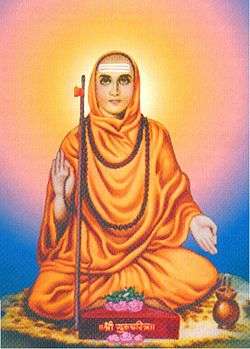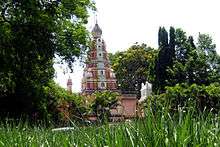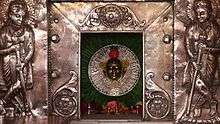Narasimha Saraswati
| Narasimha Saraswati नृसिंह सरस्वती | |
|---|---|
 Narasimha Saraswati Painting | |
| Nationality | Indian |
Narasimha Saraswati (1378−1459) was a guru.[1] According to the Shri GuruCharitra, he is the second avatar of Dattatreya in Kaliyuga after Shripad Shri Vallabha.[2]
Life
Shri Narasimha Saraswati lived from 1378 to 1459 (Shaka 1300 to Shaka 1380).[3] Saraswati was born into a Deshastha Brahmin family in Karanjapur, which is modern-day Lad-Karanja (Karanja), in the Washim district Maharashtra Vidarbha region of India.[4] His father (Madhav) and his mother (Amba-Bhavani) initially named him Narahari or Shaligramadeva, with the surname Kale.


Saraswati was a quiet child, who did not speak much during childhood. This lead his parents to worry about his speech ability; however, Saraswati showed through hand gestures that after his upanayana (munja), he would be able to speak. He started speaking after his munja, which so impressed the vedas and Brahmins in the village that it was talked about, with senior learned Brahmins coming to him for learning.
Saraswati left home in 1386 at a tender age of 8 all alone and went on a pilgrimage to Kashi on foot. He took Sannyasa at Kashi from Shri Krishna Saraswati. The second part of his name came from this guru, who eventually named him Shri Narasimha Saraswati. (This is a Sanskrit name.)
After becoming a guru, Saraswati visited several holy places before returning to Karanja at age 30 to meet his parents. He visited various places before settling in Ganagapura (Ganagapur)[5] (now in the state of Karnataka) for the last 20 years of his life.[6]
Towards the end of his life, Saraswati met with the Muslim king (Sultan) of Bidar who was possibly Mahmood Shah Bahmani I of the Bahamani Sultanate, who was the area ruler at that time.
Now his karma for that avatar had completed. Thus he decided to take samadhi. He left for the jungle of Kardali. Saraswati took nijgamananand ((निजगमनानंद) type of samadhi) in 1459.[7]
Chronology
The main events of Sri Narasimha Saraswati's life are given below. Possible years and dates are given according to descriptions of the lunar and stellar events calendar mentioned in the Shri GuruCharitra.[8]
- Sha. 1300 (1378 CE): Birth
- Sha. 1307 (1385 CE): Upanayan
- Sha. 1308 (1386 CE): Left home
- Sha. 1310 (1388 CE): Took Sanyas
- Sha. 1338 (1416 CE): Arrived back home at Lad-Karanja
- Sha. 1340 (1418 CE): Travelled along the banks of the river Gautami
- Sha. 1342 (1420 CE): Stayed at Parali-Vaijanath
- Sha. 1343 (1421 CE): Stayed at Audumbar (near Bhilavadi)
- Sha. 1344-1356 (1422-1434 CE): Stayed at Narasoba Wadi (Narasimhapur)
- Sha. 1357-1380 (1435-1458 CE): Stayed at Ganagapur
- Sha. 1380 (14 January 1459 CE): Nijanandagaman at Shrishaila Mountain
Teachings
Saraswati taught that the life of Brahmins was fully covered by the rules given in the old scriptures and the rules were to be strictly followed by the Brahmins in their daily lives inorder to achieve happiness and, ultimately, moksha. He insisted that his disciples follow these routines.[9]



Biography
Many parts of Saraswati's life are told in the Shri GuruCharitra, written by Saraswati Gangadhar.[10][11][12]
Traditions
Guru Tradition
Saraswati comes from the tradition of Shringeri Math. Jagatguru Shri Adi Shankaracharya also comes from this same tradition. The guru-lineage is as follows:
Shankar - Vishnu - Bramha - Vasishtha - Parashar - Vyas - Shuka - Gaudpadacharya - Govindacharya - Sri Adi Shankaracharya - Vishwarupacharya - Nityabodhghanacharya - Dnyanaghanacharya - Dnyanamottamacharya - Dnyanagiri - Simhagiri - Ishwaratirtha - Narasimhatirtha - Vidyatirtha - Vidyaranya - Vidyatirtha Saraswati - Malayananda Saraswati - Devatirtha Saraswati - Yadavendra Saraswati - Krishna Saraswati - Narasimha Saraswati.
Disciple Tradition
Shri Narasimha Saraswati had several disciples. They include:
- Shri Madhav Saraswati from Prayag
- Bal-Saraswati
- Krishna Saraswati
- Upendra Saraswati
- Sadananda Saraswati
- Dnyanajyoti Saraswati
- Siddha Saraswati
Siddha Saraswati is possibly the original writer of the Sanskrit GuruCharitra, which was later translated to Marathi by Shri Saraswati Gangadhar.
Legacy
Saraswati's house where he was born is located in Karanja. Although the house is no longer in the original shape, some parts remain and have been converted into a temple.[13]
Final disciple tradition
Saraswati's final disciple tradition is as follows:
Shri Narasimha Saraswati - Madhavendra Saraswati - Amritendra Saraswati (Amritananda) - Gaganendra Saraswati - Madhavendra Saraswati (Madhav Saraswati).
After Madhav Saraswati, the tradition split into two branches:
- Eknath - Shrikrishna - Bramhadas
- Vitthal Saraswati - Ambika Saraswati - Amrit
References
- ↑ Shri Dattatreya Dnyankosh by Dr. P. N. Joshi (Shri Dattateya Dnyankosh Prakashan, Pune, 2000)
- ↑ http://www.sreedattavaibhavam.org/sree-nrusimha-saraswati-swamy
- ↑ Shri Narasimha Saraswati (Karanja) page with Shri Guru Charitra.
- ↑ http://www.gurumandir.org/
- ↑ "Ganagapur". Retrieved 18 September 2014.
- ↑ "Shri Guru Charitra.". Retrieved 18 September 2014.
- ↑ Akkalkot Niwasi Shree Swami Samarth (Shri Narasimha Saraswati) Complete Biography
- ↑ Bharatiya Itihas Sanshodhan Mandal trimonthly 9.4 (Gurucharitratil Aitihasik Mahiti, J. S. Karandikar) pp.6-16; Maharashtramahodayacha Purvaranga: N.S.K. Gadre, pp.68
- ↑ Shri Narasimha (Nrusimha) Saraswati (Karanja) page with Brief life history of Shri Gurumaharaj.
- ↑ Shri GuruCharitra (Sri Gurucharitra) (new, abbreviated version) online
- ↑ Shri GuruCharitra (Sri GuruCharitra) see point 2 on this page to see the difference between modern and old Shri Guru-Charitra
- ↑ Sree Guru Charitra Complete online book in English by Acharya Ekkirala Bharadwaja.
- ↑ Shri Gurumandir Sansthan, Karanja - Birthplace of Shri Nrusimha (Narasimha) Saraswati Swami Maharaj - Home Page of Gurumandir - a Lord Dattatreya Temple
External links
- dattaganagapur.com
- Detailed information along with pictures
- http://saibharadwaja.org/books/srigurucharitra/readbook.aspx?book=43&chapter=0
